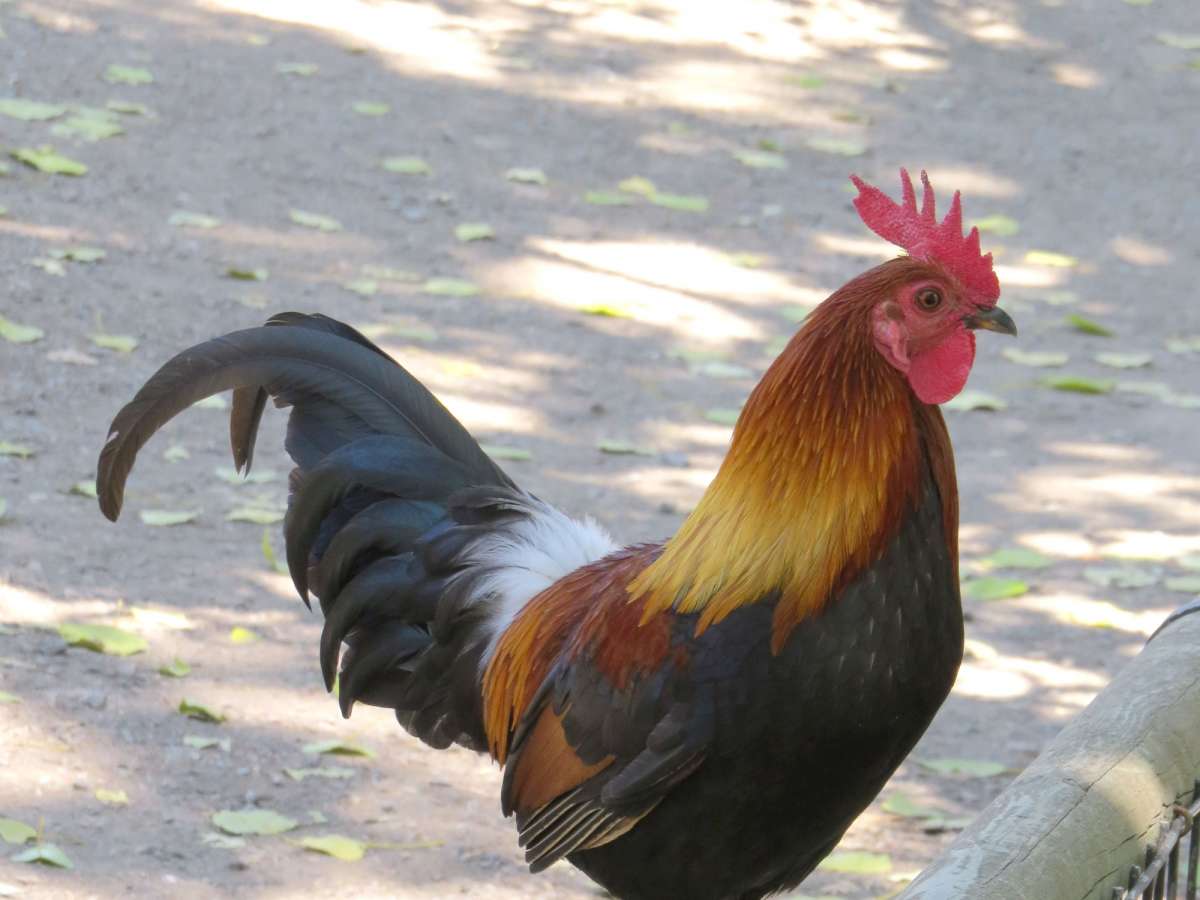Description
Red junglefowl are slightly smaller than domestic chickens. Females weigh about 1 kg (2 .25 pounds) and males weigh about 1.5 kg (3.25 pounds). Males and females are sexually dimorphic, meaning their bodies look different. The males are brightly colored, with red faces, reddish bodies, golden necks and backs, white fluffy feathers at their rump and fourteen long arching tail feathers. The feathers look black, but are iridescent blue, green and purple in direct light.
Females are smaller and cryptic in color, meaning their coloration is camouflage. This helps them to blend into the background, especially if they are sitting on eggs and caring for chicks. Female body feathers are brown, their neck and part of the back is a dark yellow with black and their combs and wattles are small. They have a fan-shaped brown tail.
Classification
- Class
- Aves
- Order
- Galliformes
- Family
- Phasianidae
- Genus
- Gallus
- Species
- G. gallus
- Conservation Status
- Least Concern
Social Life: Junglefowl live in small flocks with a dominant male, several females and their chicks and sometimes subordinate males. The dominant male has a large comb (crest on head) and wattles (flesh hanging down on both sides of the beak), showing he is healthy. Male junglefowl are more likely to be found solo or with one or two other bachelors.
Habitat and Range: Red Junglefowl range across South and Southeast Asia, including the islands off the coast such as the Philippines and Indonesia. Junglefowl prefer disturbed areas and are often found where humans have removed vegetation to plant crops. They drink surface water, but do not appear to need it.
Junglefowl flocks have a smaller territory than many other birds such as pheasants. They require some type of tall vegetation to roost at night; females and chicks roost lower and roosters higher.
Diet: Junglefowl primarily forage on the ground for seeds, fruits and nuts. They will eat arthropods (insects), small reptiles such as lizards and small mammals opportunistically. Occasionally they will forage for fruit and seeds in trees.
Lifespan: Red Junglefowl can live 12 – 15 years.
Predators: Predators of the Junglefowl are large birds such as hawks and eagles, reptiles and small carnivores.
Reproduction: Junglefowl are sexually mature at five months. At three months their mother kicks them out of the flock; they either form their own flock or join another existing flock. In some parts of India, Thailand and Vietnam, Junglefowl mate in the dry season. Elsewhere they mate at any time so long as there is an abundance of food. Eggs take 21 days to hatch; the chicks fledge at 4-5 weeks. Female junglefowl lay one egg per day; the average clutch size is 8 eggs.
- Information
-
Description
Red junglefowl are slightly smaller than domestic chickens. Females weigh about 1 kg (2 .25 pounds) and males weigh about 1.5 kg (3.25 pounds). Males and females are sexually dimorphic, meaning their bodies look different. The males are brightly colored, with red faces, reddish bodies, golden necks and backs, white fluffy feathers at their rump and fourteen long arching tail feathers. The feathers look black, but are iridescent blue, green and purple in direct light.
Females are smaller and cryptic in color, meaning their coloration is camouflage. This helps them to blend into the background, especially if they are sitting on eggs and caring for chicks. Female body feathers are brown, their neck and part of the back is a dark yellow with black and their combs and wattles are small. They have a fan-shaped brown tail.
Classification
- Class
- Aves
- Order
- Galliformes
- Family
- Phasianidae
- Genus
- Gallus
- Species
- G. gallus
- Conservation Status
- Least Concern
- Lifestyle
Social Life: Junglefowl live in small flocks with a dominant male, several females and their chicks and sometimes subordinate males. The dominant male has a large comb (crest on head) and wattles (flesh hanging down on both sides of the beak), showing he is healthy. Male junglefowl are more likely to be found solo or with one or two other bachelors.
Habitat and Range: Red Junglefowl range across South and Southeast Asia, including the islands off the coast such as the Philippines and Indonesia. Junglefowl prefer disturbed areas and are often found where humans have removed vegetation to plant crops. They drink surface water, but do not appear to need it.
Junglefowl flocks have a smaller territory than many other birds such as pheasants. They require some type of tall vegetation to roost at night; females and chicks roost lower and roosters higher.
Diet: Junglefowl primarily forage on the ground for seeds, fruits and nuts. They will eat arthropods (insects), small reptiles such as lizards and small mammals opportunistically. Occasionally they will forage for fruit and seeds in trees.
Lifespan: Red Junglefowl can live 12 – 15 years.
Predators: Predators of the Junglefowl are large birds such as hawks and eagles, reptiles and small carnivores.
Reproduction: Junglefowl are sexually mature at five months. At three months their mother kicks them out of the flock; they either form their own flock or join another existing flock. In some parts of India, Thailand and Vietnam, Junglefowl mate in the dry season. Elsewhere they mate at any time so long as there is an abundance of food. Eggs take 21 days to hatch; the chicks fledge at 4-5 weeks. Female junglefowl lay one egg per day; the average clutch size is 8 eggs.

